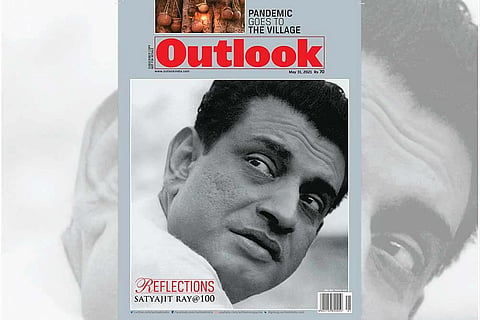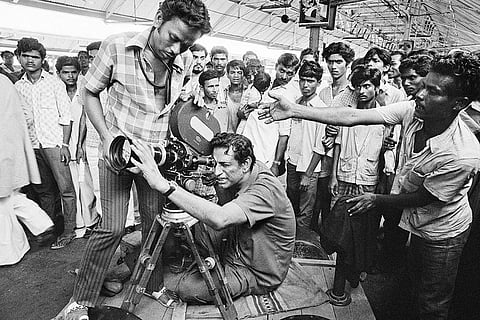Two children running through the white feathery fronds of kash flowers towards a distant train—it’s the children one remembers in Pather Panchali, their wide eyes and eager faces full of hope. It was Apu and Durga who led to my only meeting with Satyajit Ray. I went to meet Ray in his Bishop Lefroy Road library, with a request to use the Apu-Durga shot in a calendar on historic films. Immersed in his books, he raised his eyes once to grant the request and pass me on to the requisite person; then dropped his eyes again, leaving me with a memory of the book piles and the brooding silence.
Uncle Auteur
India’s only honorary Oscar-winning director could think like a child and cast children to perfection
Nothing I saw then led me to believe that he had an instinctive understanding of the way children thought, and could treat them as equals and write for them with curiosity and delight, apart from casting them to perfection. There is Ratan in Postmaster, a little boy looking for the right shade of white to paint flowers with, and, of course, the ones in the Feluda films, Sonar Kella and Jai Baba Felunath. Ray’s films are filled with children and he was one of the few directors who knew how to handle them, something that my friend Rituparno Ghosh tried to emulate when he started his career in feature films with Hirer Angti.
ALSO READ: The ‘Normal’ Lens
For someone with no time for idle chatter, and who spent his days thumbing through the red haalkhatas in which he wrote and scribbled or peering through viewfinders, Ray was very approachable where children were concerned. Kushal Chakraborty, who played the part of the kidnapped Mukul in Sonar Kella, spoke about how Ray would play chess with him and how he wondered why his father was so in awe of the tall man—Kushal couldn’t see any reason for it.
If you asked Ray how he managed to handle children, he would possibly have said, “I don’t know”—something he frequently scribbled in the margins of his scripts. Feluda also introduced another young actor to the Ray pantheon, Topshe, played by Siddhartha Chatterjee, who declared himself impressed by Ray’s total control over any situation, his quick decision-making and his time management.
ALSO READ: Ray Of Hope
A gift for handling child actors is a talent that filmmakers are expected to possess—even though most often they may not. What is less expected are Ray’s stories featuring Feluda and Professor Shanku, which started in print before they made the leap to celluloid. In his writings he seemed to plumb the depths of childlike curiosity and wonder—though the word he used was kishor, which translates these days as ‘young adult’. Those stories were turned out in clutches of 12 for publication in Sandesh before being printed as individual books.
Of course, it ran in the family—Ray’s father and grandfather both wrote for children, Upendrakishore Roychowdhury’s Tuntunir Boi and Sukumar Ray’s world of Lewis Carroll Jabberwocky were part of his growing up. Ray’s cousin Leela Majumdar inherited it as well and they were later to delve into the possibilities of reviving the children’s magazine Sandesh that Upendrakishore created.
ALSO READ: Message In The Medium

But then Ray was illustrating his father and grandfather’s stories long before he ventured into film, and he had already started seeing through a child’s eyes. He was drawn to Pather Panchali by the illustrations he was doing for an abridged version of the Bibhuti Bhushan story named Aam Antir Bhepu. The sketches led him to film and then to the almost forgotten Sandesh, which began with colourful folk cover graphics and went on to Feluda. The world of Sandesh was populated with curious beasts, weird machines and talking birds to which Ray added his detective armed with his mind (magojastra), a curious nephew-cum-Watson and an eccentric and erratic writer friend. He wrote 35 Feluda stories, beginning with Feludar Goyendagiri (Feluda’s Investigations) and most people agreed that Feluda had much in common with his creator because like the young Manik, he came from what was then East Bengal and lost his father at an early age. He also lived on Rajani Sen Road in South Kolkata, close to Ray’s own Ballygunge haunts, and many of the stories are set in and around the area.
ALSO READ: Most Wanted
The stories were immediately popular, very visual like all his work, and it is debatable whether more children have seen the films than have read the books. Soumitra Chatterjee was his ideal Feluda, but the actors who followed have their fans too. Certainly, at one of my book launches, when I had Sabyasachi Chakraborty as chief guest, my nephew gasped ‘Feluda!’ in awe at his presence and by then Ray was long gone.
That is one side of Ray’s writing. There is also the one modern teens might call the geeky Ray, the one who inherited his father’s whimsy where strange devices were concerned, created Professor Shanku, toyed with Pterodactyl eggs and artificial intelligence, and even anticipated the robot servant that is being experimented with in Japan in Anukul, a story about a man who picks one up in a shop on Chowringhee.
ALSO READ: The Unerring Casting Eye

But the most iconic of them all for those with a fascination for Ray trivia is the story named Bonku Babu’s Friend, which was about a diffident alien stranded on earth after his spaceship took off without him. Bonku Babu was slated to be filmed in Hollywood, but lost out to Steven Spielberg, with Ray fans buzzing about conspiracy theories since the stories were so similar and Martin Scorsese declaring that Bonku Babu was the inspiration behind ET.
Sadly, to most, Ray is the polymath, the brilliant sun that no Indian director can ever hope to match, creating frames that stupefy adults and exploring themes that seem to have nothing to do with children at all. Ray is the auteur who explores Tagore, the problems of rural poverty and the corruption of big city life—all themes that in the academic context are more pressing than exploring the sensitive preoccupations with the adult life around them that immerse many children. This delusion persists as more and more academic studies probe the serious side of Ray, who remains India’s sole Oscar-winning director—though yes, Ray’s eye for detail and the intricate costumes he devised for the ghosts in Goopy Gyn fascinate artists and academics alike.
However, from Pather Panchali to Agantuk, Ray continued to use children in his films. And he treated them like children, not like diminutive adults, and they were perfectly natural wherever he placed them—the same phenomenon one finds in the stories. Life goes on in print and in celluloid with all its ups and downs, with no punches pulled for the sake of innocence, because that is how the world is. A more politically correct society might grumble that Feluda’s habit of smoking Charminars is injurious to children’s mental health, but so far the stories have been allowed to exist without being tampered with in that respect.
ALSO READ: The Household On Bishop Lefroy Road
To children he would have been Manik Kaku, who took them shooting on school holidays and let them win at chess without making it too obvious. The Uncle who told them stories about Feluda and Goopy Gyne Bagha Byne, with a scattering of ghosts and comic illustrations thrown in for good measure. A hundred years later, he lives on for them through his words, moving pictures and the depth of his understanding.
(Views are personal.)
Anjana Basu writes for children. Her byline has appeared in various magazines and she has worked with Rituparno Ghosh on his films, notably The Last Lear.